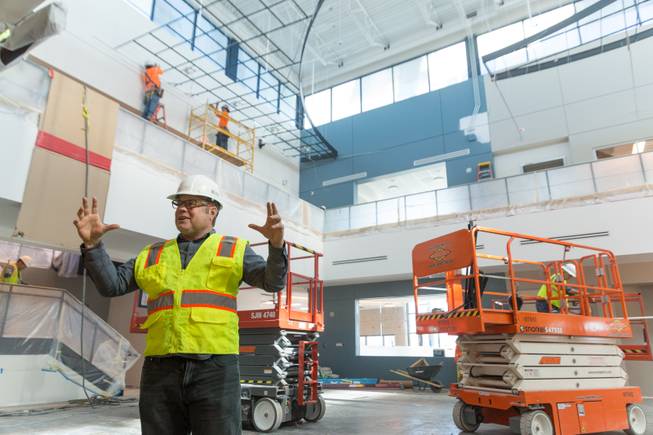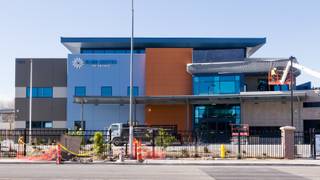
Cory Nelson, Executive Director of the Blind Center of Nevada, shows the Great Room, which will be used as an area for members to gather to eat and watch musical performances, during a walk-through of a new facility in Las Vegas, Thursday, Jan. 11, 2018. The design of the facility was inspired by the layout of the Brooklyn Bowl with the goal of avoiding an institutional feel.
Sunday, Jan. 21, 2018 | 2 a.m.
Gustavo Covarrubias-Garcia remembers the short story “Cathedral.” While the 1983 work of fiction by Raymond Carver has many themes, Covarrubias-Garcia recalls the way the character with vision treated the character without sight.
“The story emphasizes how the narrator knows nothing about being blind,” he said. “It’s true. People don’t know what we’re capable of doing.”
It’s not just the rest of the world that doesn’t understand how resilient the blind community is, Covarrubias-Garcia added. Sometimes people who are newly impaired or blind don’t know the potential they have. “That’s why I work at the Blind Center. They’ve empowered me to do things I never thought achievable.”
According to the National Federation of the Blind, more than 108,000 people in Nevada are blind or visually impaired.
The Blind Center of Nevada, which has about 300 regular clients, offers a variety of programming designed for their needs.
“We offer classes on mobility training and Braille,” said Todd Imholte, the chief development and marketing officer with the blind center. “But we are helping people beyond the disability.”
The organization is scheduled to open its new building in February with the hope it can enhance its mission, which includes growing its electronic recycling program.
This program encourages businesses to hand in expired electronics such as computer monitors, copiers, cellphones, surveillance equipment, microphones, office phones, medical equipment, scientific equipment, vintage electronics, flat panel televisions and DVD players for a disposal fee of $30.
“We’ve kept 2.2 million pounds of electronic waste (out of) the landfill,” said Cory Nelson, executive director of the Blind Center.
“It provided 50 to 60 percent of our funding,” Nelson said. “It also provides employment to people who are blind.”
Some employees work in the call center, while others disassemble products by feel.
The National Federation of the Blind estimated that about 62 percent of blind or visually impaired people are unemployed. As a result, Nelson said that many live at or below the poverty level.
And many clients who became blind or impaired later in life have lost jobs.
“We’ve had people tell us they feel like a failure because they couldn’t work and support their family,” Nelson said. “These jobs mean a lot to our members.”
With the new building, there might be additional recycling roles and new programs such as a culinary component that would teach participants the basics of cooking and how to help with catering.
The instructor position needs to be filled, but the culinary component could be up and running this spring, with space rented for events and some of the Blind Center clients catering.
“The class could practice holding events and, when it’s time to do an actual event, the instructor would decide who is ready,” Nelson said.
Aside from prospective jobs, the new center will expand many of extracurricular activities such as music and ceramics classes.
“By teaching them to play an instrument or learn ceramics, they see that anything is possible,” Nelson said. “They see they can work hard and gain a skill.”
Covarrubias-Garcia dedicated himself to music never knowing how it would turn out. He now heads the Blind Center’s band, Broken Spectacles, which has played at local venues including the House of Blues at Mandalay Bay.
Although the center is hoping those who visit regain confidence through classes and activities, the building also serves another need.
“It’s good for them to have a place where they can socialize with each other,” Nelson said. “There are certain things that I, as a sighted person, don’t understand. This allows them to talk with people who are dealing with some of the same issues.”

